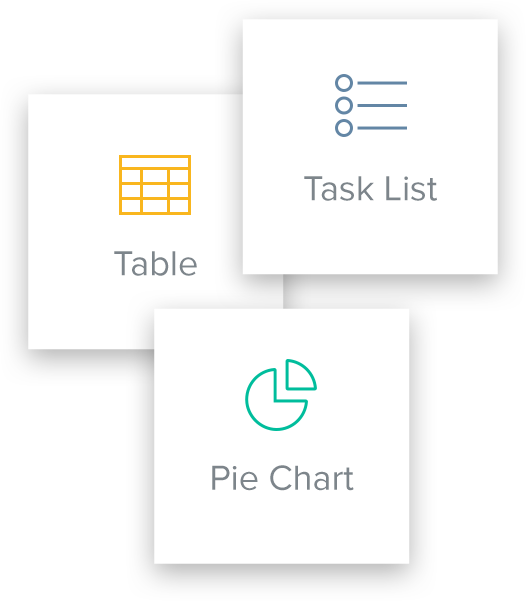The Ultimate Glossary of Product Management Terms You Need to Know
Includes FREE Templates and How-to Guides – 2023
Updated by Xtensio
Product Management Terms A-Z
Welcome to the ultimate glossary of Product Management terms! Whether you’re a seasoned Product Manager or just starting out, this comprehensive list will serve as your go-to guide for understanding the jargon, slang, and technical terms used in the field.
A
A/B Testing
A method of comparing two versions of a webpage or app to determine which performs better.
Acceptance Criteria
The conditions that a software product must satisfy to be accepted by a user, customer, or stakeholder.
Agile
A project management and product development approach that prioritizes flexibility and collaboration.
API (Application Programming Interface)
A set of rules and protocols for building and interacting with software applications.
Artifact
A document or tool used in Agile frameworks like Scrum, which could be a product backlog, sprint backlog, or other records.
Assumption Testing
The process of validating the assumptions or hypotheses made during the planning phase of a project.
Audience Segmentation
Dividing a larger market into smaller groups based on various factors like demographics, behavior, or psychographics.
Automated Testing
Using automated tools to execute test cases without human intervention.
B
Backlog
A list of tasks or features that are planned for development.
Bandwidth
Refers to the resources—time, team members, etc.—available to work on a project.
Beta Testing
The phase where a product or feature is tested by real users in the target audience but before it’s fully launched.
Big Data
Extremely large data sets that can be analyzed to reveal patterns, trends, and associations.
Black Box Testing
A testing method where the tester doesn’t need to know the internal structures or workings of the application.
Business Case
A justification for a proposed project or investment, usually supported by cost-benefit analysis.
Business Intelligence (BI)
The strategies and technologies used by enterprises for data analysis and business information.
Business Model Canvas
A strategic management tool that provides a framework for developing new or documenting existing business models.
Business Model Canvas Template
How to Use Business Model Canvas
Business Requirements
The critical activities of an enterprise that must be performed to meet its organizational objective(s).
Business Requirements Document
How to Write a Business Requirements Document
Buy-In
The approval and support of a decision or idea by stakeholders or team members.
C
CAC (Customer Acquisition Cost)
The cost associated with acquiring a new customer.
Churn Rate
The percentage of customers who stop using or purchasing a product during a certain timeframe.
Click-Through Rate (CTR)
The ratio of users who click on a specific link to the number of total users who view a page, email, or advertisement.
Cohort Analysis
A subset of behavioral analytics that takes the data from a given dataset and breaks the data into related groups for analysis.
Competitive Analysis
The process of identifying your competitors and evaluating their strategies to determine their strengths and weaknesses relative to your own product or service.
Competitive Analysis Template
How to Do Competitive Analysis
Concept Testing
The process of evaluating a new product idea before it goes into development.
Conversion Rate
The percentage of users who take a desired action, such as making a purchase or filling out a form.
Cost-Benefit Analysis
An analytical process to evaluate the benefits of an action compared to its costs.
Critical Path
The sequence of stages determining the minimum time needed for an operation.
Cross-Functional Team
A group of people with different functional expertise working toward a common goal.
Customer Journey Map
A visual representation of the process a customer goes through to achieve a goal with your product or service.
Customer Journey Map Template
An Intuitive Guide to Customer Journey Mapping
Customer Persona
A semi-fictional representation of your ideal customer based on market research and real data.
User Persona Template
How To Create A User Persona

Customer Retention
The activities and actions companies and organizations take to reduce the number of customer defections.
Customer Segmentation
The practice of dividing a customer base into groups of individuals that are similar in specific ways relevant to marketing.
Customer Validation
The phase in the Lean Startup Method where you test your MVP (Minimum Viable Product) with real customers to see if it solves a real problem.
CX (Customer Experience)
The sum of all interactions a customer has with a business and its products or services.
Customer Experience Strategy Fundamentals in 2023
D
Data-Driven Decision Making
The practice of basing decisions on the analysis of data rather than purely on intuition.
Dashboard
A real-time user interface, showing a graphical presentation of the current status and historical trends of key performance indicators.
Deadlines
The time by which a task or project should be completed.
Decision Matrix
A tool used to evaluate and prioritize a list of options, based on a set of weighted criteria.
Deliverables
Tangible or intangible goods or services produced as a result of a project that is intended to be delivered to a stakeholder.
Demographics
Statistical data relating to the population and particular groups within it, often used for market segmentation.
Dependency
A task or activity that relies on the completion of another task or activity.
Design Thinking
A methodology used for solving complex problems, focusing on empathy, ideation, and experimentation.
DevOps
A set of practices that involve the collaboration and communication of both software developers and IT professionals to automate the process of software delivery and infrastructure changes.
Discovery Phase
The initial stage in a project where you identify the problem, the customer, and the potential solutions.
Documentation
Written records that provide evidence of or information about a particular subject, process, or activity.
Dogfooding
The practice of using one’s own product to test and understand its functionalities and limitations.
Drip Campaign
A method used in direct marketing to acquire customers through lead nurture programs.
Due Diligence
An investigation or audit of a potential investment or product to confirm all facts, such as reviewing all financial records, plus anything else deemed material.
E
Early Adopters
The first customers to adopt a new product or technology before the general population.
Earned Value Management (EVM)
A project management technique for measuring project performance and progress in an objective manner.
Elevator Pitch
A brief, persuasive speech that you can use to spark interest in what you or your organization does.
End-to-End Testing
Testing the flow of an application from start to finish to ensure the entire process of a user’s interaction works smoothly.
End User
The person who actually uses a particular product, as opposed to those who developed or sell it.
Engagement Metrics
Data that measures how actively users interact with a product, often used to gauge the product’s success.
Epic
A large user story that cannot be delivered as defined within a single Agile sprint or iteration and is split into smaller stories.
Exit Strategy
A plan for converting an investment or venture into cash, as in the sale of a company or a product line.
Experience Design (XD)
The practice of designing products, processes, services, events, or environments focused on user engagement and the overall experience.
Experimentation
The act of trying out a new procedure, idea, or activity in order to discover something unknown or to test a principle.
Exploratory Testing
An approach to software testing that is concisely described as simultaneous learning, test design, and test execution.
F
Feature Creep
The excessive expansion or addition of new features in a product, which can result in a complicated user interface and a lack of focus.
Feature Flag
A technique in software development that allows you to enable or disable features during runtime without deploying new code.
Feedback Loop
A system where the output or result influences the next action or decision.
Figma
A cloud-based design tool that enables multiple people to collaborate in real-time.
Fishbone Diagram
Also known as Ishikawa or cause and effect diagram, it’s a visualization tool for categorizing the potential causes of a problem.
Flowchart
A type of diagram that represents a workflow or process, showing the steps as boxes and their order by connecting them with arrows.
Focus Group
A diverse panel of people assembled to participate in a guided discussion about a particular product before it hits the market.
Freemium
A business model where a basic product or service is provided free of charge, but money is charged for additional features.
Front-End
The part of a software application that interacts with the user, as opposed to the back-end that deals with data and business logic.
Full Stack
A developer who is competent in both front-end and back-end technologies.
G
Gap Analysis
The process of comparing actual performance with potential or desired performance to identify gaps or areas of improvement.
Go-to-Market (GTM) Strategy
The plan that outlines how a company will sell its products to customers.
Growth Hacking
A set of unconventional marketing experiments that aim to achieve market growth, usually for startups.
GUI (Graphical User Interface)
A type of user interface that allows users to interact with a software application through graphical elements like icons and windows.
H
Heuristic Evaluation
A usability engineering method for finding usability problems in a user interface design.
High-Fidelity Prototype
A detailed and interactive representation of the product’s design, often used for user testing.
High-Level Overview
A summary that provides a concise but comprehensive description of the main points of a plan or project.
Histogram
A graphical representation of the distribution of a dataset, often used in statistical analysis.
Hotfix
A small piece of code developed to correct a major software bug or fault.
Hypothesis Testing
A statistical method that is used in making decisions using data, often data that is collected through controlled experiments.
Hygiene Factors
Elements that are essential for the existence of motivation but do not energize or boost performance.
I
Ideation
The creative process of generating, developing, and communicating new ideas.
Impact Mapping
A strategic planning technique that helps to define the value and impact of a project or product.
Incremental Development
A development methodology where a project is divided into small parts, and each part is developed and refined individually and incrementally.
Information Architecture
The art and science of organizing and labeling websites, intranets, online communities, and software to support usability and findability.
Innovation Accounting
A way of evaluating progress when traditional financial metrics and KPIs may not be applicable.
Integration Testing
Testing of combined parts of an application to determine if they function correctly together.
Intellectual Property (IP)
Legal rights that result from intellectual activity in the industrial, scientific, literary, or artistic fields.
Interactive Prototype
A high-fidelity prototype that allows user interaction and simulates the functionality of the final product.
Iteration
A single development cycle in agile methodologies, typically lasting from one to four weeks.
IVR (Interactive Voice Response)
A technology that allows a computer to interact with humans through the use of voice and DTMF tones input via a keypad.
J
Jira
A popular project management software tool commonly used in agile development.
Journey Mapping
See Customer Journey Map.
Just-in-Time (JIT)
An inventory strategy that aims to improve a business’s ROI by reducing in-process inventory and associated carrying costs.
Kano Model
A theory for product development and customer satisfaction developed by Noriaki Kano, which categorizes customer preferences into five categories: Basic Needs, Performance Needs, Excitement Needs, Indifferent Needs, and Reverse Needs.
K
Kanban
A visual framework used to implement agile methods in software development.
Key Performance Indicator (KPI)
A measurable value that demonstrates how effectively a company is achieving key business objectives.
Key Result (KR)
A quantifiable metric that reflects the achievement of an Objective in the OKR (Objectives and Key Results) framework.
Knowledge Base
A centralized repository for information: a public library, a database of related information about a particular subject.
Knowledge Transfer
The practical problem of transferring knowledge from one part of an organization to another.
L
Landing Page
The webpage where a visitor first enters a website, often designed specifically to prompt a certain action or result.
Lean Methodology
A systematic method for the elimination of waste within a manufacturing system, often applied to software development and product management.
Lifecycle
The series of changes that a product goes through from its inception, through its design and manufacture, to its end of life.
Localization
The process of adapting a product or content to a specific locale or market.
Low-Fidelity Prototype
A simplified version of the product, often paper-based, that helps in visualizing and testing design concepts.
LTV (Lifetime Value)
The prediction of the net profit attributed to the entire future relationship with a customer.
M
Market Fit
The degree to which a product satisfies a strong market demand.
Market Research
The action or activity of gathering information about consumers’ needs and preferences.
Market Segmentation
The process of dividing a broad consumer or business market into sub-groups of consumers or segments.
Market Share
The portion of a market controlled by a particular company or product.
Metrics
Measurable values that demonstrate how effectively a company is achieving key business objectives.
Milestone
A significant event or stage in the life of a project.
Minimum Viable Product (MVP)
The version of a new product that allows a team to collect the maximum amount of validated learning about customers with the least effort.
Mockup
A model or replica of a machine or structure for instructional or experimental purposes.
MoSCoW Method
A prioritization technique used in management, business analysis, and software development to reach a common understanding with stakeholders.
Multivariate Testing
A technique for testing a hypothesis in which multiple variables are modified.
N
Net Promoter Score (NPS)
An index ranging from -100 to 100 that measures the willingness of customers to recommend a company’s products or services.
North Star Metric
The single metric that best captures the core value that your product delivers to customers.
Nudge Theory
A concept in behavioral science, political theory, and economics which proposes positive reinforcement and indirect suggestions as ways to influence behavior.
O
OKR (Objectives and Key Results)
A framework for defining and tracking objectives and their outcomes.
Onboarding
The action or process of integrating a new employee or user into an organization or familiarizing a new customer or client with one’s products or services.
Opportunity Cost
The loss of potential gain from other alternatives when one alternative is chosen.
Outsourcing
The business practice of hiring a party outside a company to perform services and create goods that could be performed in-house.
Overhead
The ongoing administrative expenses that can’t be attributed to any specific business activity but are still necessary for the business to function.
P
Pain Point
A specific problem that prospective customers of your business are experiencing; in other words, you can think of pain points as problems, plain and simple.
Persona
See Customer Persona.
Pivot
Structured course correction designed to test a new fundamental hypothesis about the product, strategy, and engine of growth.
Platform
A group of technologies that are used as a base upon which other applications, processes, or technologies are developed.
PMF (Product-Market Fit)
See Market Fit.
Point of Sale (POS)
The time and place where a retail transaction is completed.
Portfolio Management
The centralized management of one or more project portfolios to achieve strategic objectives.
Positioning
How a product is placed in the market, relating to competitors and the minds of consumers.
Brand Positioning Canvas Template
Post-Mortem
An analysis or review reported after the completion of a project to evaluate what happened and what could be learned for the future.
Product Backlog
See Backlog.
Product Life Cycle
See Lifecycle.
Product Owner
The person responsible for setting, prioritizing, and evaluating the work generated for a Scrum Team to make sure it is in line with the product strategy and goals.
Product Roadmap
A high-level visual summary that maps out the vision and direction of your product offering over time.
Proof of Concept (POC)
A demonstration, the purpose of which is to verify that certain concepts or theories have the potential for real-world application.
Prototyping
The activity of creating prototypes of software applications, i.e., incomplete versions of the software program being developed.
Q
QA (Quality Assurance)
A way of preventing mistakes and defects in manufactured products and avoiding problems when delivering products or services to customers.
Quantitative Data
Data that can be measured and written down with numbers.
R
Rapid Prototyping
The quick creation of a full-scale model of a product or system for examination and testing.
Retrospective
A meeting held by a project team at the end of a project or process to discuss what was successful about the project or time period covered, what could be improved, and how to incorporate the successes and improvements in future projects or phases.
Return on Investment (ROI)
A performance measure used to evaluate the efficiency of an investment or to compare the efficiency of a number of different investments.
S
SaaS (Software as a Service)
A software licensing and delivery model in which software is provided over the Internet, eliminating the need to install it on individual computers.
Scalability
The capability of a system, network, or process to handle a growing amount of work, or its potential to be enlarged to accommodate that growth.
Scrum
An agile framework for managing knowledge work, with an emphasis on software development.
Scrum Master
The facilitator for an agile development team; responsible for managing the exchange of information between team members.
Segmentation
See Market Segmentation.
SEO (Search Engine Optimization)
The practice of increasing the quantity and quality of traffic to your website through organic search engine results.
Service Blueprint
A technique used for service innovation, but has also found applications in diagnosing problems with operational efficiency.
Silo
A system, process, department, etc. that operates in isolation from others.
Smoke Testing
Preliminary testing to reveal simple failures severe enough to reject a prospective software release.
Sprint
The basic unit of development in Scrum; generally, a time-boxed period during which specific work has to be completed and made ready for review.
Stakeholder
Anyone who has an interest in the project or will be affected by its outcomes.
Standup
A daily meeting where team members provide updates on what they are working on and any blockers they are facing; also known as a daily scrum.
Story Points
A unit of measure for expressing the overall size of a user story, feature, or other pieces of work.
SWOT Analysis
A strategic planning technique used to help a person or organization identify strengths, weaknesses, opportunities, and threats related to business competition or project planning.
SWOT Analysis Template
How To Do SWOT Analysis
T
TCO (Total Cost of Ownership)
The purchase price of an asset plus the costs of operation.
Technical Debt
The implied cost of additional rework caused by choosing an easy solution now instead of using a better approach that would take longer.
Time-to-Market
The length of time it takes from a product being conceived until its being available for sale.
Traction
A measure of a product’s engagement with its market, a.k.a. product-market fit.
Trade-off
A situation that involves losing one quality or aspect of something in return for gaining another quality or aspect.
Turnkey
A type of project that is constructed so that it can be sold to any buyer as a completed product.
U
UI (User Interface)
The space where interactions between humans and machines occur.
Usability Testing
A technique used in user-centered interaction design to evaluate a product by testing it on users.
User Acceptance Testing (UAT)
The last phase of software testing performed after functional, integration and system testing is done.
User Experience (UX)
A person’s emotions and attitudes about using a particular product, system or service.
User Flow
The path taken by a prototypical user on a website or app to complete a task.
User Story
A tool used in Agile software development to capture a description of a software feature from an end-user perspective.
V
Value Proposition
The unique value that a product or service provides to its customers, often used to entice potential customers into becoming actual customers.
Version Control
The management of changes to documents, computer programs, large websites, and other collections of information.
Vertical Market
A market in which vendors offer goods and services specific to an industry, trade, profession, or other group of customers with specialized needs.
Viral Coefficient
The number of new users an existing user generates.
Vision Statement
A future-oriented declaration of the organization’s purpose and aspirations.
Voice of the Customer (VoC)
A term used to describe the in-depth process of capturing customer’s expectations, preferences, and aversions.
W
Waterfall Model
A sequential (non-iterative) design process, used in software development processes, in which progress is seen as flowing steadily downwards (like a waterfall) through the phases of conception, initiation, analysis, design, construction, testing, deployment, and maintenance.
White-Box Testing
An internal perspective of the system, as well as programming skills, are used to design test cases based on internal structures.
Wireframe
A visual guide that represents the skeletal framework of a website or app.
Workflow
The sequence of industrial, administrative, or other processes through which a piece of work passes from initiation to completion.
X
XaaS (Anything as a Service)
A collective term that stands for a number of things including X as a service, anything as a service, or everything as a service.
Y
Yield
The amount of product produced in a manufacturing process, often expressed as a percentage.
Z
Zero-Based Budgeting
A method of budgeting in which all expenses must be justified for each new period.
Zombie Scrum
A term used to describe a situation where an Agile development team uses the Scrum framework but lacks understanding and the broader Agile principles.
This concludes our comprehensive glossary of Product Management terms. We hope this serves as a valuable resource for both newcomers and seasoned professionals in the field. 👋
Learn more about Product Management: Mastering Product Management: Definition, Strategy, and Steps













